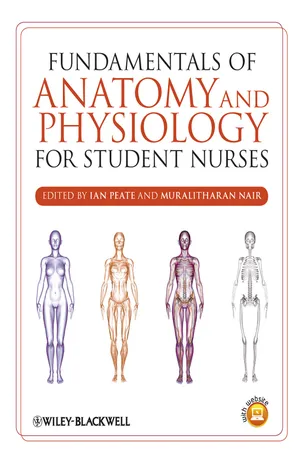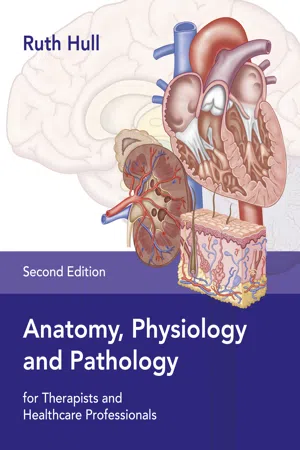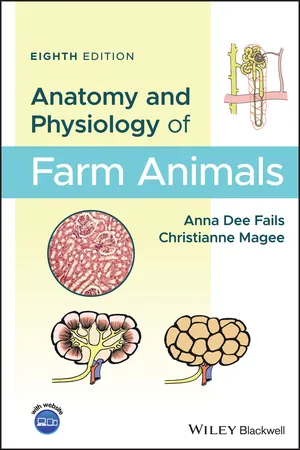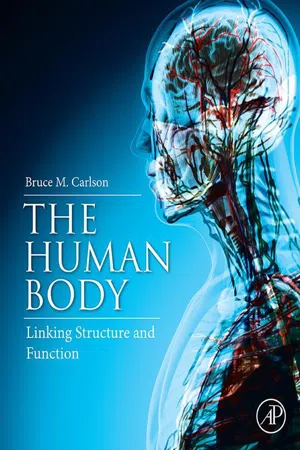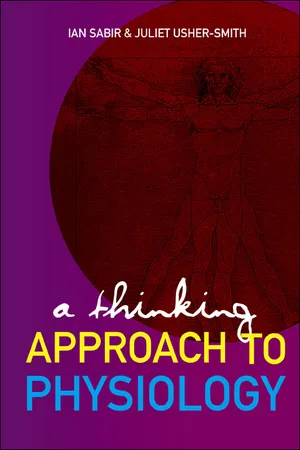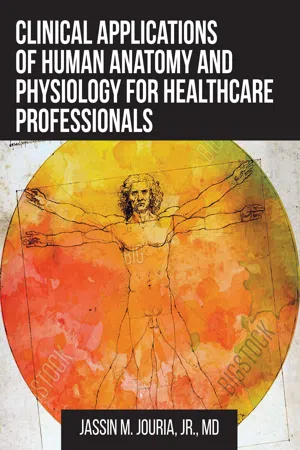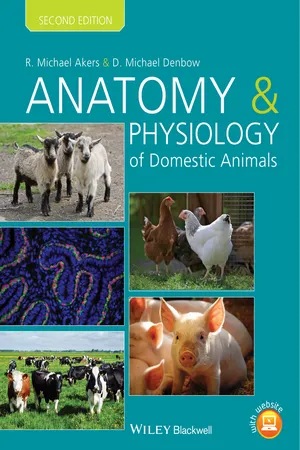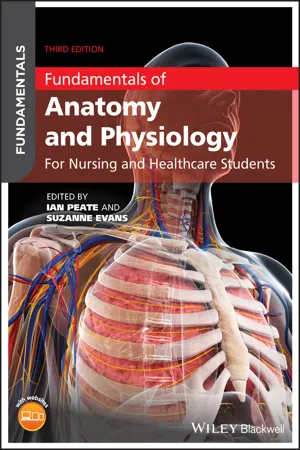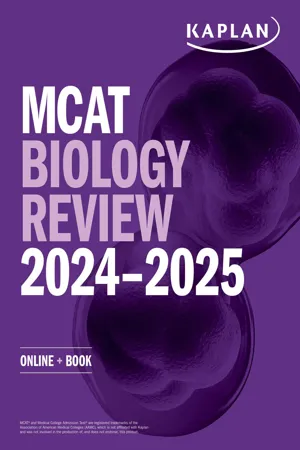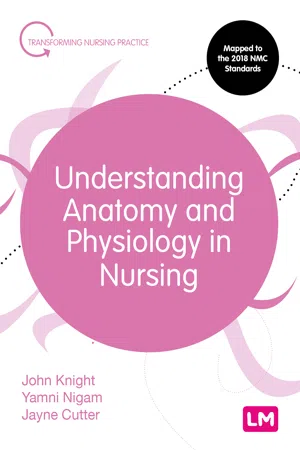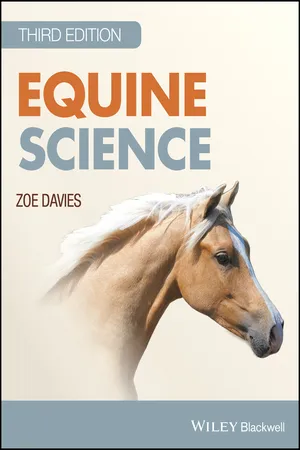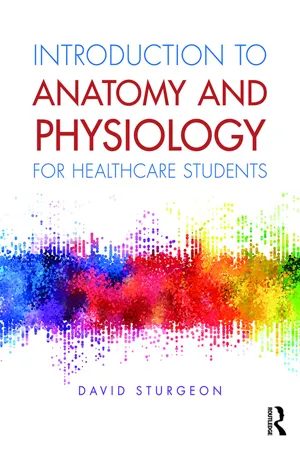Biological Sciences
Respiratory System
The respiratory system is responsible for the exchange of oxygen and carbon dioxide in the body. It includes the nose, trachea, bronchi, and lungs, where the process of breathing and gas exchange takes place. The system also helps regulate the body's pH balance and plays a role in vocalization.
Written by Perlego with AI-assistance
Related key terms
12 Key excerpts on "Respiratory System"
- Ian Peate, Muralitharan Nair, Ian Peate, Muralitharan Nair(Authors)
- 2011(Publication Date)
- Wiley-Blackwell(Publisher)
11 The Respiratory System Anthony WheeldonContents IntroductionOrganisation of the Respiratory SystemThe upper respiratory tractThe lower respiratory tractLarynx Trachea Bronchial treeBlood supplyRespirationPulmonary ventilationMechanics of breathingWork of breathingVolumes and capacitiesControl of breathingExternal respirationGaseous exchange Factors affecting diffusionVentilation and perfusionTransport of gasesTransport of oxygen (O2 )Transport of carbon dioxide (CO2 )Acid base balanceInternal respirationConclusion Glossary References ActivitiesTest your knowledge- List five major structures of the upper and lower respiratory tract.
- What is the main function of the Respiratory System?
- Describe the physiological process of breathing – which muscles are utilised?
- What factors may increase or decrease a person’s rate and depth of breathing?
Learning outcomes On completion of this section the reader will be able to:- List the main anatomical structures of both the upper and lower respiratory tract
- Describe the events of pulmonary ventilation
- Explain how the body is able to control the rate and depth of breathing
- Discuss the principles of external respiration
- Describe how oxygen and carbon dioxide are transported around the body
Body mapIntroductionHuman cells can only survive if they receive a continuous supply of oxygen. As cells use oxygen a waste gas, carbon dioxide, is produced. If allowed to build up, carbon dioxide can affect cellular activity and disrupt homeostasis. The principal function of the Respiratory System therefore is to ensure that the body extracts enough oxygen from the atmosphere and disposes of the excess carbon dioxide. The collection of oxygen and removal of carbon dioxide is referred to as respiration. Respiration involves the following four distinct processes: pulmonary ventilation, external respiration, transport of gases and internal respiration. Although all four are examined in this chapter only pulmonary ventilation and external respiration are the sole responsibility of the Respiratory System. As oxygen and carbon dioxide are transported around the body in blood, effective respiration is also reliant upon a fully functioning cardiovascular system.- eBook - ePub
- Ruth Hull(Author)
- 2021(Publication Date)
- Lotus Publishing(Publisher)
Two systems work very closely to ensure there is a continuous supply of oxygen to all the cells of the body and a continuous removal of carbon dioxide. These are the respiratory and cardiovascular systems. The Respiratory System takes in oxygen from the air we breathe and eliminates carbon dioxide, while the cardiovascular system transports these two gases between the Respiratory System and the cells of the body.Gaseous exchangeThe primary function of the Respiratory System is the intake of oxygen and the elimination of carbon dioxide. This exchange of gases is called respiration and it takes place between the atmosphere, the blood and the cells in different phases:• Pulmonary ventilation: The word pulmo refers to the lungs, and pulmonary ventilation is another term for breathing. Air is inspired, or breathed, into the lungs and expired, or breathed, out of the lungs.• External respiration (pulmonary respiration): This is gaseous exchange between the lungs and the blood. In external respiration, the blood gains oxygen and loses carbon dioxide.• Internal respiration (tissue respiration): This is gaseous exchange between the blood and tissue cells. In internal respiration the blood loses oxygen and gains carbon dioxide.NB: Cellular respiration (oxidation) is a metabolic reaction that takes place within a cell. It uses oxygen and glucose and produces energy in the form of ATP. A by-product of cellular respiration is carbon dioxide.OlfactionThe Respiratory System also functions in olfaction, which is the sense of smell. One of its structures, the nose, houses the olfactory receptors, and olfaction is discussed in more detail in chapter 6 .Sound productionVibrating air particles produce sound. As we breathe air out, air passes through the larynx (voice box) where there are specialised membranes called vocal cords. The air causes these to vibrate and produce sounds, which are converted into words by the muscles of the pharynx, face, tongue and lips. The pharynx, mouth, nasal cavity and paranasal sinuses also act as resonating chambers for sound. - eBook - ePub
- Anna Dee Fails, Christianne Magee(Authors)
- 2018(Publication Date)
- Wiley-Blackwell(Publisher)
Chapter 19 The Respiratory System- Upper Respiratory Tract
- Nose
- Paranasal Sinuses
- Pharynx
- Larynx
- Trachea and Bronchi
- Thorax
- Lungs
- Pleura
- Physiology of Respiration
- Ventilation
- Gas Exchange
- Gas Transport in Blood
- Control of Ventilation
Learning Objectives
- Define and be able to explain the significance of the bold italic terms in this chapter.
- Follow a breath of air from the moment it enters the external nostril until it reaches the alveoli, describing the anatomy and contrasting the differences between the different domestic species along the way. Identify the major paranasal sinuses and their locations.
- Diagram and/or describe the anatomy of the larynx and explain its role in protecting the airway; identify the nerves that produce movement of the laryngeal cartilages.
- Describe the disposition of pleura in the thoracic cavity, naming its different parts and describing its role in creating a potential space.
- Diagram the transpulmonary pressure, pleural pressure, and alveolar pressure during inspiration and expiration. When are the lungs completely devoid of air?
- Describe the factors that determine gas exchange in the lungs versus in tissues.
- Discuss the control of ventilation. Explain how hyperventilation can result in apnea.
Oxygen is a vital requirement of animals. An animal may survive for days without water or for weeks without food, but life without oxygen is measured in minutes. Delivering oxygen and removing carbon dioxide (the product of cellular respiration) are the two major functions of the Respiratory System. The processes involved with these functions related to gases include ventilation (movement of air in and out of the lungs), gas exchange between air and blood in the lungs, gas transport in blood, and gas exchange between blood and cells at the level of the tissues. Secondary functions of the Respiratory System include assistance in the regulation of the pH of the body fluids, assistance in temperature control, and phonation (voice production). - eBook - ePub
The Human Body
Linking Structure and Function
- Bruce M. Carlson, Bruce M. Carlson(Authors)
- 2018(Publication Date)
- Academic Press(Publisher)
Chapter 11The Respiratory System
Abstract
The Respiratory System consists of the nose, where inspired air is conditioned by filtration, warming and humidification, the pharynx, the lower respiratory tree, extending from the trachea to the bronchioles, and the alveoli, where actual gas exchange occurs. Throughout the Respiratory System, structural features ensure that the passage, conditioning and filtration of air are carried out efficiently. The thin walls of the alveoli and the close approximation of capillaries enable efficient gas exchange within the lungs. Olfaction occurs in a specialized area of the upper nose, beginning with a set of odorant receptors and continuing with nerves of the olfactory tract, which sends olfactory signals to the brain. Phonation occurs in the larynx, another region of the Respiratory System that is used for a purpose other than passing air and exchanging gasses.Keywords
Respiratory System; breathing; nose; air conditioning; olfaction; pharynx; larynx; phonation; trachea; lungs; bronchi; bronchioles; alveoli; gas exchangeVirtually all animals need to take in oxygen and remove carbon dioxide in order to survive. Some are small enough that gas exchange through their outer surfaces is sufficient, but almost any animal big enough to be seen without a microscope requires some form of specialized Respiratory System. Most aquatic animals have evolved external sets of feathery gills that extract oxygen from the water and allow carbon dioxide to escape from the body. Vertebrate land animals, on the other hand, developed very complex internal lungs that are subdivided into enormous numbers of tiny air sacs lined with a thin moist epithelium that allows the efficient passage of gases to and from the networks of capillaries that underlie the epithelium. The epithelium of the lungs is very delicate, and in order to protect it, mammals have evolved a long channel, consisting of the nostrils, the pharynx, the trachea, and bronchial passages, that conditions the air before it reaches the lungs. Without this, the cell lining of the lungs would become seriously damaged by breathing in air that is too cold, or hot, or dry. - eBook - ePub
- Ian N Sabir, Juliet A Usher-Smith(Authors)
- 2008(Publication Date)
- WSPC(Publisher)
CHAPTER 4 The Respiratory SystemAll living cells have an absolute requirement for a regular supply of energy. Energy is usually handled in the form of the molecule adenine triphosphate (ATP), a product of a series of metabolic reactions within the mitochondria of each cell together referred to as respiration. A fuel such as glucose is the only essential substrate for respiration. However, the efficiency of the process is increased by up to eight times in the presence of O2 , which ultimately takes the role of an oxidising agent. The provision of O2 to the mitochondria, and the removal of the waste product of respiration, CO2 , are therefore essential for life. This chapter considers how these two goals are achieved at the level of the whole organism.The process of delivering O2 to and removing CO2 from the body may be split into three: transporting the gases into and out of the organism, getting the substance to or from the active cells within the organism and finally getting the substance to or from the mitochondria within each cell. In organisms such as bacteria where surface area to volume ratio is large and distances within the organism are small, simple diffusion is sufficient to solve these problems. This same strategy is used to supply O2 to the human cornea. However, in larger multicellular organisms such as humans, distances are ordinarily limiting. We therefore require a dedicated organ, the lungs, to provide a large surface area over which gas exchange can occur. Furthermore, we also require a specialised circulatory system, the bloodsteam, to carry these gases around the body. We will begin by discussing the transport of gases into and out of the lungs, then focus on the exchange of gases between the lungs and the blood before finally considering how these gases are carried in the blood. The transport of this blood to the tissues is dealt with in Chapter 5 - Jassin M. Jouria(Author)
- 2018(Publication Date)
- BrownWalker Press(Publisher)
The composition of the Respiratory System involves a number of body parts from the nose and sinuses to the lungs. In this chapter, students will learn basic anatomy of the Respiratory System and a brief description of how each component functions. An overview of various functions of respiratory circulation, gas exchange, and respiratory controls will also be discussed.- ■ Anatomy of the Respiratory System
The Respiratory System is responsible for supplying body cells with oxygen and getting rid of carbon dioxide that is formed as the cells use up that oxygen. The upper and lower Respiratory Systems, the lungs, and the function of each are important, working together to provide the body with one of the most basic requirements of life – air.Figure 9-1 Respiratory System.We will follow the respiratory cycle from the act of inhaling air to its exhalation. Respiration begins through the inhalation of air through the nose or the oral cavity (mouth). The noseThe main cavity of the nose is situated between the roof of the mouth and the base of the brain cavity.2 The structure of the external nose itself is formed by nasal and frontal bones superiorly located to the frontal bone that forms the bridge and the root of the nose itself. The frontal bone, more commonly known as the forehead, serves as the ‘root’ of the nasal bone, located between the eyes and about eyebrow level. The bilateral frontal processes of the nose are located high on the bridge of the nose and also form laterally along inside of the eye sockets. These partially form the base of the eye sockets along with the temporal process of the zygomatic bone. The remainder of the external nose shape is constructed of cartilage.Figure 9-2 Nasal cavity.Air-filled spaces are found within the nasal cavity – these are known as sinuses. Simply put, bone forms the upper portion of the nose, while cartilage supports the lower part of the nose.Flexible plates known as hyaline cartilage form much of the nose structure. Smaller bits of cartilage known as the minor alar bridge the distance between the base of the shaft of the nose and the outer projections of the nostrils. Dense, fibrous connective tissues actually form the nostrils, while major alar- eBook - ePub
- R. Michael Akers, D. Michael Denbow(Authors)
- 2013(Publication Date)
- Wiley-Blackwell(Publisher)
Treatment first involves lifestyle changes in order to decrease the animal's exposure to allergens. If this proves ineffective, the animals may need to be given corticosteroids (prednisone, dexamethasone, triamcinolone) to suppress inflammation. Long-term use of corticosteroids can cause problems, particularly heart problems, immune suppression, and decreased ability to heal. The animals can also be given bronchodilators (clenbuterol, pirbuterol, albuterol) to help decrease smooth muscle contraction and reduce mucus production. Although oral administration is the easiest, the most effective treatment is to administer these drugs directly into the airways. This results in minimal systemic side effects, but it requires a special mask.If the lung is injured by infectious agents, it can produce cytokines and chemokines, which come from monocytes, injured epithelial or endothelial cells, or other cells involved in the inflammatory response. These compounds are involved in the inflammatory response.Chapter summaryRespiratory System1. The respiratory and circulatory systems are the means by which nutrients are delivered to each cell and wastes are removed.2. The functions of the Respiratory System include gas exchange, regulation of blood pH, olfaction, filtration of inspired air, production of sounds, and elimination of some water and heat via expired air.3. Functionally, it can also be divided into two sections: (1) The conducting portion consists of a series of connected tubes that filters, warms, moistens, and conducts air to and from the lungs; (2) the respiratory portion is the site of gas exchange between the air and blood, and consists of the respiratory bronchioles, alveolar ducts, alveolar sacs, and alveoli.Functional anatomyNose1. The nose is the externally visible portion of the Respiratory System. The external nares (nostrils) are the external openings to the respiratory tract. The philtrum is the area between the lips and nose.2. The nasal cavity extends from the external nares to the caudal nares, and is separated from the mouth by the hard and soft palates.3. The nasal cavity communicates with the paranasal sinuses, and posteriorly with nasopharynx through two openings called the internal nares or choanae.4. The paranasal sinuses are air-filled cavities within some bones of the skull. The major ones are the frontal and maxillary sinuses.The pharynxThe pharynx connects the nasal cavity and mouth to the larynx and esophagus, respectively. It directs food and air into the digestive and Respiratory Systems. The pharynx is divided into the oropharynx and nasopharynx, and the common caudal portion is the laryngopharynx. - eBook - ePub
Fundamentals of Anatomy and Physiology
For Nursing and Healthcare Students
- Ian Peate, Suzanne Evans, Ian Peate, Suzanne Evans(Authors)
- 2020(Publication Date)
- Wiley-Blackwell(Publisher)
This chapter has examined the anatomy and physiology of the Respiratory System. The Respiratory System is divided into the upper and lower respiratory tracts. The lower respiratory tract consists of lung tissue and major airways. The structures within the lower respiratory tract are fragile and susceptible to infection, the main function of the upper respiratory tract therefore is the protection of the lower respiratory tract. The main function of the lower respiratory tract is the reoxygenation of arterial blood and the expulsion of excess carbon dioxide – a process called respiration. Respiration involves four distinct physiological processes: pulmonary ventilation (breathing), external respiration (gaseous exchange), transport of gases and internal respiration. Only the first two processes are the sole responsibility of the Respiratory System, and effective respiration is also reliant upon a fully functioning cardiovascular system.Glossary
Accessory muscles:Muscles not normally involved in respiration that can be utilised to increase inspiration.Acid–base balance:The mechanisms by which the body maintains arterial blood pH between 7.35 and 7.45.Alveolar minute ventilation:The amount of air reaching the respiratory portion of the lungs each minute.Anatomical dead space:The portion of the airway not involved in the exchange of oxygen and carbon dioxide (also referred to as the conducting zone).Aorta:First major blood vessel of arterial circulation. Emerges from the left ventricle of the heart.Apex:The tip or highest point of a structure.Apneustic centre:Area of the pons (brainstem), which influences inspiration.Arytenoid cartilage:Cartilage tissue involved in the production of the voice.Aspiration:The inhalation of solid or liquid substances.Asthma:A chronic inflammatory disorder of the lungs. It causes the bronchi and bronchioles to become inflamed and constricted. As a result, airflow becomes obstructed, often resulting in a characteristic wheeze. - No longer available |Learn more
MCAT Biology Review 2024-2025
Online + Book
- (Author)
- 2023(Publication Date)
- Kaplan Test Prep(Publisher)
bags of air; gas exchange is not the only function of the Respiratory System. The Respiratory System also serves essential roles in thermoregulation, immunity, and pH regulation. As we go through the individual systems within the human body, take special note of how each system is integrated with the other systems. One of the more clear connections is the binding of oxygen to hemoglobin in the lungs and in the rest of the circulatory system—a concept we will expand upon in the next chapter, along with the effects of altitude, pH, and chemicals on this binding.GO ONLINE
You've reviewed the content, now test your knowledge and critical thinking skills by completing a test-like passage set in your online resources!CONCEPT SUMMARY
Anatomy and Mechanism of Breathing
- Air is drawn in through the nares, and through the nasal cavity and pharynx, where it is warmed and humidified. It is filtered by nasal hairs (vibrissae) and mucous membranes. It then enters the larynx, followed by the trachea. The trachea divides into two mainstem bronchi, which divide into bronchioles, which divide into continually smaller passages until they reach the alveoli.
- Alveoli are small sacs that interface with the pulmonary capillaries, allowing gases to diffuse across a one-cell-thick membrane.
- Surfactant in the alveoli reduces surface tension at the liquid–gas interface, preventing collapse.
- The pleurae cover the lungs and line the chest wall.
- The visceral pleura lies adjacent to the lung itself.
- The parietal pleura lines the chest wall.
- The intrapleural space lies between these two layers and contains a thin layer of fluid that lubricates the two pleural surfaces.
- The diaphragm is a thin skeletal muscle that helps to create the pressure differential required for breathing.
- Inhalation is an active process.
- The diaphragm and external intercostal muscles
- Available until 29 Sep |Learn more
- John Knight, Yamni Nigam, Jayne Cutter(Authors)
- 2020(Publication Date)
- Learning Matters(Publisher)
Chapter 4 The Respiratory System Nikki WilliamsChapter aims
After reading this chapter, you will be able to:- describe the key functions of the Respiratory System;
- identify the major anatomical structures of the Respiratory System;
- highlight the regions of the conducting and respiratory zones;
- describe the processes of ventilation and gaseous exchange;
- explain how oxygen and carbon dioxide are transported in the blood;
- describe the mechanisms of respiratory control and the role played by the Respiratory System in acid base balance.
Case study: Jake – asthma
Jake is 13 years old and has had asthma for several years. His asthma is generally well controlled, but it is made worse if he suffers from a respiratory tract infection or is exposed to a substance to which he is allergic. One afternoon, Jake and his classmates were on a cross-country run when after a few minutes Jake complained of a tight chest and started to cough profusely. Unfortunately, Jake had left his salbutamol (bronchodilator) inhaler in his bag in the changing room. Jake’s close friend Isaac stayed with him and reassured him, while another friend ran to tell their PE teacher who found Jake’s school bag. Within a few minutes, the teacher was able to give Jake his inhaler. After four puffs of salbutamol, Jake was feeling well enough to walk slowly back to school.Introduction
Chronic respiratory diseases, such as the asthma affecting Jake, are routinely encountered and managed by nurses. Since the respiratory tract is in constant contact with the external environment, it is vulnerable to infection from pathogens and physical damage from toxic irritants. A significant problem in the UK and throughout the world is smoking, which progressively damages the airway and lung tissue, increasing the risk of chronic obstructive pulmonary disease (COPD) and other lung diseases, including cancer. This chapter will focus on the primary role of the respiratory tract in facilitating gaseous exchange. - eBook - ePub
- Zoe Davies(Author)
- 2017(Publication Date)
- Wiley-Blackwell(Publisher)
Chapter 6 The Respiratory SystemThe horse requires a constant supply of oxygen to stay alive. At all times, in all living cells, energy liberation from nutrients to produce adenosine triphosphate (ATP) continues without interruption in the mitochondria. This energy results from the oxidation of complex carbon-containing substances. In simple terms, glucose is broken down in the presence of oxygen to release carbon dioxide (CO2 ) and energy. The waste product CO2 is toxic and must be quickly eliminated from the body. Mitochondria need a steady supply of oxygen to release the potential energy stored in fuels in muscle cells, such as fat and glycogen. However, most mitochondria in muscle cells are a long way from any oxygen in the air. Respiration is the process by which the horse takes oxygen into its body and also rids it of CO2 .The horse is a relatively large animal and therefore will need to take in more oxygen. In a 5-furlong race, for example, a horse will breathe in approximately 1800 litres of air, of which 378 litres is oxygen and most of the rest is nitrogen. The Respiratory System consists of the nose, pharynx, larynx, trachea, bronchi and lungs. The horse does not breathe through its mouth and nose as humans do but breathes through its nares (nostrils) only. Essentially, respiration is the exchange of gases between the horse and its environment. The horse has a system of respiratory organs which are designed to bring oxygen into the cells of the body and to expel CO2 and water.There are essentially three steps to the process of gaseous exchange:- • Breathing (pulmonary ventilation) – airflow into and out of the lungs.
- • External respiration – exchange of gases at the alveoli/blood interface.
- • Internal respiration – exchange of gases at the tissue cells/blood interface in the body.
The primary function of the Respiratory System is exchange of CO2 - David Sturgeon(Author)
- 2018(Publication Date)
- Routledge(Publisher)
2 ) in the air sacs of the lungs (alveoli) is about 100 mmHg compared to about 40 mmHg in venous and pulmonary capillary blood (since oxygen has been ‘used up’ by the body’s cells to produce energy/ATP). The net direction of diffusion for oxygen, therefore, is from the alveoli to the pulmonary capillaries (it moves from a high to a low concentration/ pressure). However, we will return to this later in the chapter once we have discussed alveolar diffusion in more detail.Airways
The Respiratory System consists of the airways, the lungs, the muscles of respiration and the areas of the nervous system which control the rate and depth of ventilation. The airways are often divided into the upper and lower respiratory tract at the larynx (voice box). The upper respiratory tract consists of the nasal cavity, the mouth and the pharynx (Figure 9.1 ). Although we breathe using our nose and our mouth we are born nose breathers. Newborns are known as ‘obligate nose breathers’ since they demonstrate a strong preference to breathe through their nose rather than their mouth. This instinct is partly explained by differences in the anatomic proportions of their respiratory tract compared to an adult and the fact that they have not yet achieved control of the muscles in their mouths (or anywhere else for that matter). This can be problematic if the child has nasal congestion, as they frequently do, and most parents have looked on with a degree of alarm as their child’s nostrils flair with the effort of breathing with a blocked up nose. However, even as an adult, the nasal cavity is a much better channel for respiration than the mouth since it is lined with a ciliated mucous membrane which contains mucus-producing goblet cells. At first glance this seems a little counter intuitive – how are cilia (hair-like projections) and mucus of benefit when breathing? Firstly, as we noted in Chapter 6
Index pages curate the most relevant extracts from our library of academic textbooks. They’ve been created using an in-house natural language model (NLM), each adding context and meaning to key research topics.
